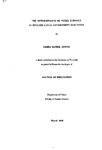THE DETERMINANTS OF VOTER TURNOUT IN ENGLISH LOCAL GOVERNMENT ELECTIONS
| dc.contributor.author | DOWNE, JAMES DANIEL | |
| dc.contributor.other | School of Society and Culture | en_US |
| dc.date.accessioned | 2013-09-11T09:14:26Z | |
| dc.date.available | 2013-09-11T09:14:26Z | |
| dc.date.issued | 1998 | |
| dc.identifier | NOT AVAILABLE | en_US |
| dc.identifier.uri | http://hdl.handle.net/10026.1/1647 | |
| dc.description.abstract |
The level of local election turnout has important political and democratic implications. It is politically important because the electoral process ensures that local councillors are held directly accountable to the people. The level of voter turnout and how these votes are apportioned will determine the electoral outcome. Voter turnout also plays a significant role in our evaluation of local democracy. When voter participation is high then local democracy is perceived as being healthy, while low turnout is regarded as a sign of the public's lack of interest in the local democratic process. Given this background, therefore, it is surprising to discover that so little serious attention has been given to the subject. There is a wealth of literature written on turnout at the national level across the world, but the rate of voter participation in local elections has been relatively ignored. When local election turnout is addressed by politicians, academics and journalists alike, discussion invariably focuses upon a single issue - the low rates of participation that can be found. Indeed, local election turnout is considerably lower than that for parliamentary elections, on average approximately 40% compared with 70-75%, but the level of debate about low turnout in local elections is far from sophisticated. It is accepted as fact, for example, that local election turnout is 40% and that few local authorities deviate significantly from this figure. It is also assumed that little variation in turnout exists within the various wards comprising a local authority. Little is understood about how factors including the size of electoral units, the nature and level of party competition and the socio-economic composition of local authorities and wards can affect turnout. External factors can also play a part in raising or depressing local turnout. The general nature of the national political climate when local elections take place, will have a direct bearing upon the electorate's interest in the battle for council seats. Sometimes the political atmosphere is charged and the level of turnout will reflect this situation, just as a general air of political disinterest will contribute to lower turnout. What is important, however, is that we increase our level of knowledge about the determinants of local election turnout. Only then will we have a well-informed discussion about the level of turnout and its significance for our system of local democracy. This research is designed to examine the variation in turnout that occurs in local elections. It will identify the determinants of turnout at the local authority level and compare the results across London, the metropolitan boroughs and the English shire districts since the reorganisation of the local government system took place in the early 1970s. The variation in turnout levels will be examined by using a number of independent variables. Those local authorities which have levels of turnout that deviate significantly from the mean will be analysed in more detail. This pattern of analysis will be repeated at the ward level for the three types of local authority identified above. This dependence on aggregate data analysis will then be augmented with the analysis of data obtained from a survey and in-depth interviews. The responses to the survey and the findings from the interviews will be a valuable addition to our electoral data. This research is the first investigation that has exclusively focused on this significant topic, and analysed data covering such a large number of local authorities over a period of more than 20 years. | |
| dc.language.iso | en | en_US |
| dc.publisher | University of Plymouth | en_US |
| dc.title | THE DETERMINANTS OF VOTER TURNOUT IN ENGLISH LOCAL GOVERNMENT ELECTIONS | en_US |
| dc.type | Thesis | |
| plymouth.version | Full version | en_US |
| dc.identifier.doi | http://dx.doi.org/10.24382/3718 | |
| dc.identifier.doi | http://dx.doi.org/10.24382/3718 |
Files in this item
This item appears in the following Collection(s)
-
01 Research Theses Main Collection
Research Theses Main


